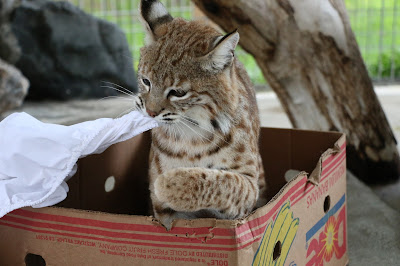 Our final salute to the hard working compassionate zookeepers at Wildwood Wildlife Park is Sasha Busjahn who has chosen the Greater Grison to highlight and imitate. Lloyd's favorite spot to sleep is inside a log; when Lloyd was off exploring Sasha crawled right in to see how comfortable it really is but we don't think she will be stealing his sleeping spot any time soon!
Our final salute to the hard working compassionate zookeepers at Wildwood Wildlife Park is Sasha Busjahn who has chosen the Greater Grison to highlight and imitate. Lloyd's favorite spot to sleep is inside a log; when Lloyd was off exploring Sasha crawled right in to see how comfortable it really is but we don't think she will be stealing his sleeping spot any time soon!
Greater grison's are mustelidae, a family of carnivorous mammals that include the badger, mink, otter and wolverine.
Greater grison's have a long body which resembles the honey badger. Greater grison's don't ever have to worry about being confused for a honey badger since the two of them will never meet each other: the honey badger lives in Africa, while the greater grison lives in Central and South America. The "grison" part of the name is an English variation of the word "gris" which is French for the color gray. Like its relative the honey badger, the greater grison is very temperamental. It is unknown if any creature outside of humans hunt them.
Greater grison's are gray in color with a black muzzle, throat, chest and underside. They have a white "U" shaped marking that runs around the top of their head tapering off near their shoulder. Greater grison's sleep during the day, hunting during the night, dawn and dusk.
Greater grison's are found in a wide range including savannas, grasslands, rainforests and evergreen forests. They prefer to live near water choosing to make their home in rocks, under tree roots or in vacated burrows. Greater grison's eat whatever is available: small mammals, birds and their eggs, lizards, amphibians, and fruits. In some areas, grisons are trapped for body parts and for the pet trade.
Grisons are agile runners, swimmers and climbers communicating by a variety of snorts, screams, barks and growls. Breeding occurs in Late August, early September and the female grison will give birth to 2-4 young.

















